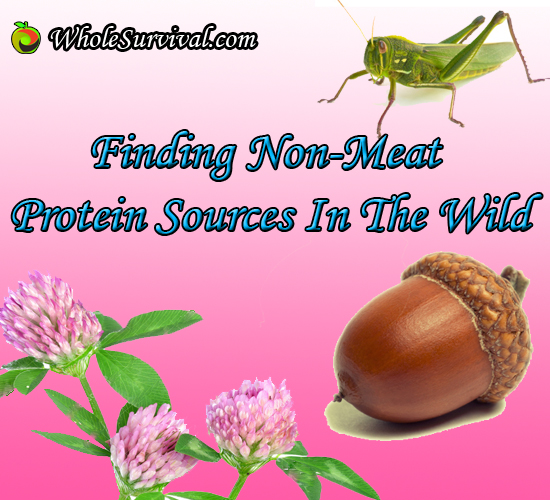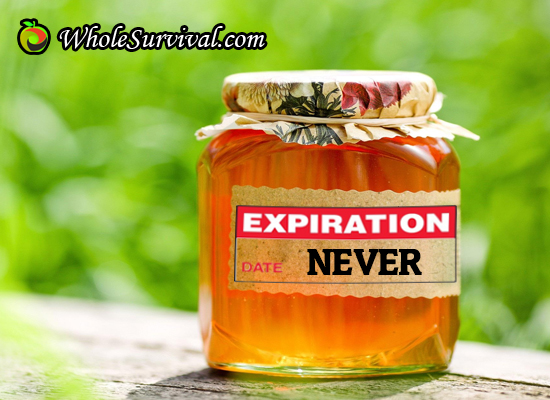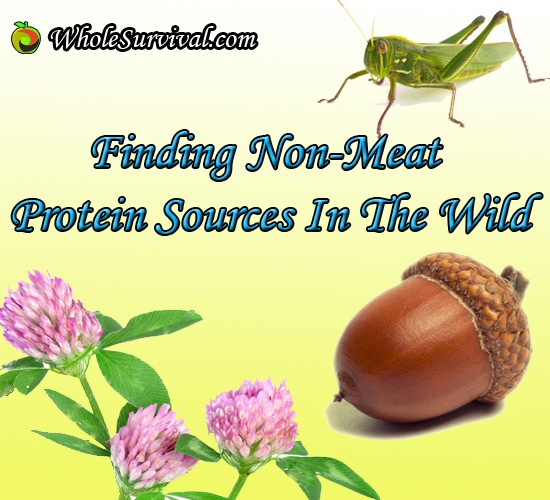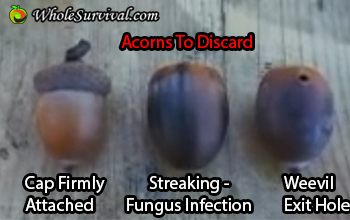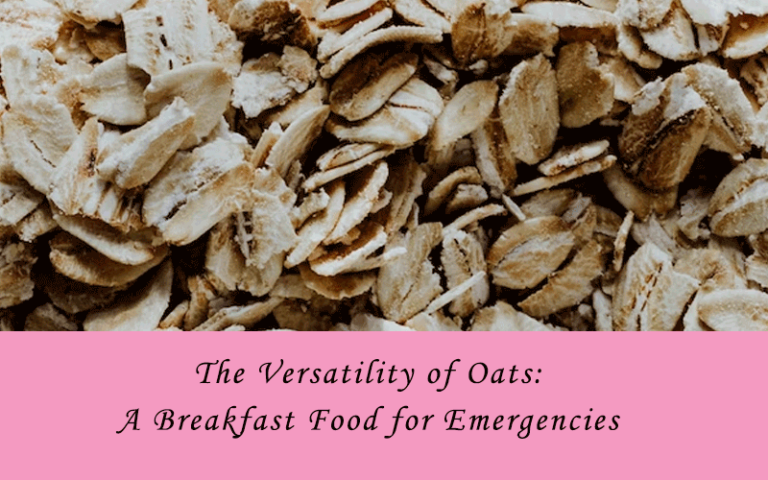Survival Foraging – Finding Non-Meat Protein Sources In The Wild – Nuts
Although we all have some plans in place to be able to eat during a SHTF scenario, whether that be having stored food, or even homesteading with animals. We can never predict everything and there is always the chance that we need to abandon our place of security and set out for a new safe location.
Since it’s difficult to carry enough food for more than a few days worth (while traveling on foot if things are that bad), it is important to know how to supplement your diet with food sources that you find along the way. Although water is more vital than food, water is not too much of a concern if you have a good portable filter. In most areas there will be some sort of water to be found that can be used.
Deriving protein from plants is not really a mystery, we are all aware that’s what vegetarians do every day. However, much of their protein will come from sources like soy, rice & beans, and processed grains like quinoa and buckwheat. Common garden vegetables that also contain protein are peas, spinach, kale, broccoli, potatoes, and even corn.
But what if you don’t have access to processed grains? What if all you had were wild (non-garden) plants to choose from?
How Much Protein Do We Need?
Before we get into the list and the numbers details, let me first put that into perspective by mentioning that the typical person needs at least 50 grams of protein to stay relatively healthy. This number would be for a non-active person. Someone, who for example is in a survival situation or who is burning calories by walking long distances everyday would need more like 100 grams of protein per day.
Nuts
This one is no secret. Nuts are a great source of protein (and fat). However, like any wild food, there will be a season as to when they will be available to forage. Most nuts are only ready in the fall. Depending on your location, your choice might be limited to certain tree species, but I will go through the most common nut bearing trees.
Acorns
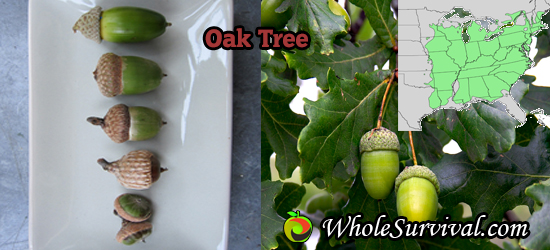
The yearly acorn crop from oak trees in North America is higher than the yearly yield of all other nut trees combined. There are more than 60 species of oak trees in North America, and all of them produce edible acorns. The only problem with acorns is that they are not edible immediately, they must be processed first to remove the high concentration of tannins.
There are numerous ways to remove the tannin from acorns, but the quickest way, and if you are on the move, the only way, would be to shell the acorns, then drop them into boiling water for a few minutes. Then transfer them to another pot of water boiling water, back and forth like this a few times until the bitter taste is completely gone. Then the nut will be safe to eat. The amount of water changes will depend on how much tannin is in the nut, which depends on the species of the oak.
The growing range shown in the image above is for the white oak (quercus alba). Red oaks have a similar range, but there are species of oak trees growing in mostly every region of North America. The larger the acorn cap, the more tannins the nut will have and so more leaching will need to be done in order to make it edible.
After all that is done, acorns do provide a complete vegetable protein, about 6% by weight. They also contain about 25% of their weight in fat and 40% in carbohydrate. So acorns can be a very valuable wild food source if you take the time to deal with the tannin leaching.
Beechnuts
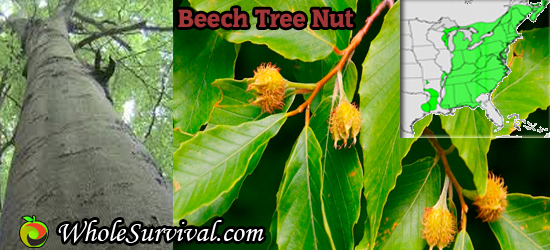
Beechnuts, or nuts from the beech tree, mature in the fall and the bur shells break open, usually after the first frost on their own, exposing two small, triangular nuts that will drop to the ground. The kernels are hard to find once they’ve fallen among leaves, so gathering them from lower branches just before they fall off is the most assured way of obtaining them.
Beechnuts have a thin shell that is easily peeled or scraped off with your fingers. Containing about 20% protein, it doesn’t take much to meet your daily requirements. They can be eaten raw right away, but if you want to keep them for more than a few days, they will need to be dried.
Walnuts
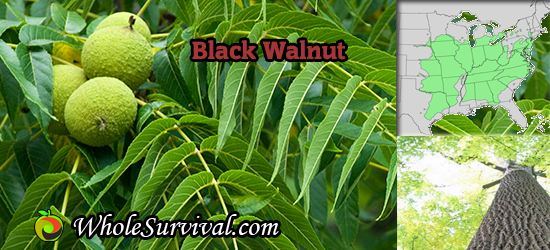
Black walnuts, to be exact also are available in the fall, mostly in the eastern part of North America, although there are a few western species. They are a real pain to crack open (a hammer and cutting pliers will be useful here), and they can and will stain pretty much anything they touch. The nutmeat is pretty much destroyed into pieces in the process). But once you deal with the shell, the nutmeat is composed of about 24% protein.
Butternut
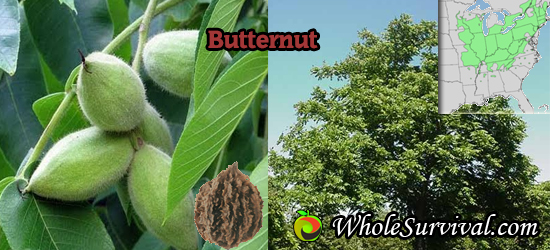
The butternut has pretty much the highest food energy of any nut; 28% protein, 61% fat and about 3,000 calories per pound. They are related to the black walnut so you will have to deal with the staining issue of the dye but cracking them open is not quite as difficult as the walnut. They can eaten straight out of the shell, or dried to avoid them from going rancid.
Hickory Nuts
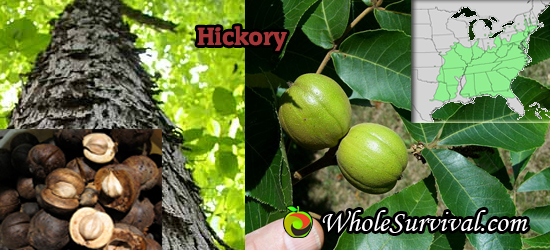
The hickory tree species is widespread throughout the eastern and central United States. There are different varieties however that produce delicious, sweet nutmeats, but others produce fruit that is almost worthless because they are too bitter or almost all shell. It’s not really easy to tell one kind from another. (The species in the image is the shagbark hickory.)
Similar to walnuts, hickories store well in the shell once they have been dried. They have a hard outer shell but are easier to crack than walnuts or butternuts, but you’ll need to give them a good pounding. Seek out hickory trees in the fall, when their nuts drop. One ounce (or about a handful) of shelled hickory nuts contains 180 calories. The same ounce serving size of hickory nuts contains 3.6 g of protein.
Pecans
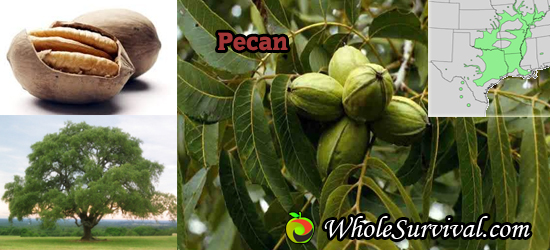
Pecans are actually a type of hickory, but is so well known that it gets it’s own common name. Pecans are a great nut, as they are easy to shell, contain plenty of nutmeat, and are nice and tasty. They range mostly in the Mississippi River Valley and much of eastern Texas and Oklahoma. In the middle of fall, the husks split into four crescent shaped pieces and the ripe, pale brown nuts fall to the ground.
Pine Nuts
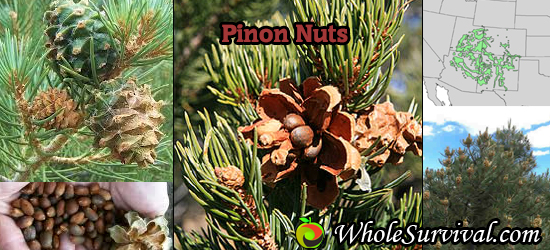
Although technically any pine tree will produce a nut, or seed, there are only a few varieties of pine trees that produce edible nuts, most of them found in the western part of North America. Ponderosa Pine, Stone Pine, Sugar Pine, Digger Pine, and Pinon Pine are the species that you will need to look for.
In the fall, the cones will open and expose the large seeds or nuts that lie within the pine cone. They will need to be shelled, but that can be done by hand if your fingers are strong enough. Pine nuts are composed of about 2/3rds fat, with 14% protein, and 13% carbohydrates.
Wild Hazelnuts
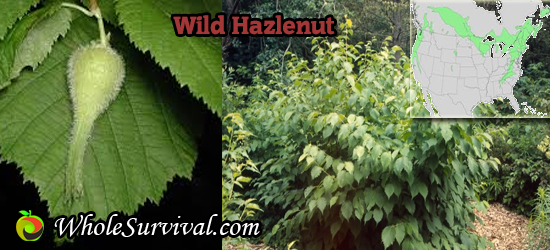
Wild Hazelnuts are different than the other nuts in two ways. First, they grow on shrub bushes not trees, which makes them easy to harvest. Second, they are ready to pick in the summer, not the fall. Also called American Filberts, unfortunately they are not as large as the domesticated filberts that you can buy at the store.
They need to be removed from the green skin or involucre and will last a long time in the shell once dried. They are 60% fat, 15% protein, and 17% carbohydrate.
Chestnuts & Chinquapins
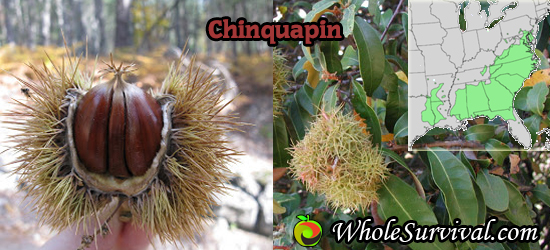
I left this for last because there are so few wild chestnuts and chinquapins left due to the fungus blight that devastated the species 100 years ago. Chinquapins are similar to chestnuts, only smaller, and also succumb to the blight, just not as quickly. If you are able to find any chestnuts, they are ready in the fall season, the protein level is low for this nut, at only 2% by weight. I have not found any concrete data on Chinquapins however, although I did find this statement: “they have more protein, carbohydrates and trace minerals than any other nut in the forest.”
It’s definitely worth it to take a look at the various species of nut bearing trees that grow in your area and when they are producing. Get familiar with them as much as you can and try to test out your nut cracking skills while you have the opportunity. Also, you’ll be able to practice your seasonal timing for getting to the nuts before the squirrels and other wildlife.
I would especially take a stab at acorns, since they take a lot more processing than the other nuts. Make sure you know how to deal with them properly so that if you are ever in a situation that you really need them, you will know exactly what to do. If you want to know what acorn flour tastes like before you go through the trouble of all that work, you can use the product link below to buy some already processed.

